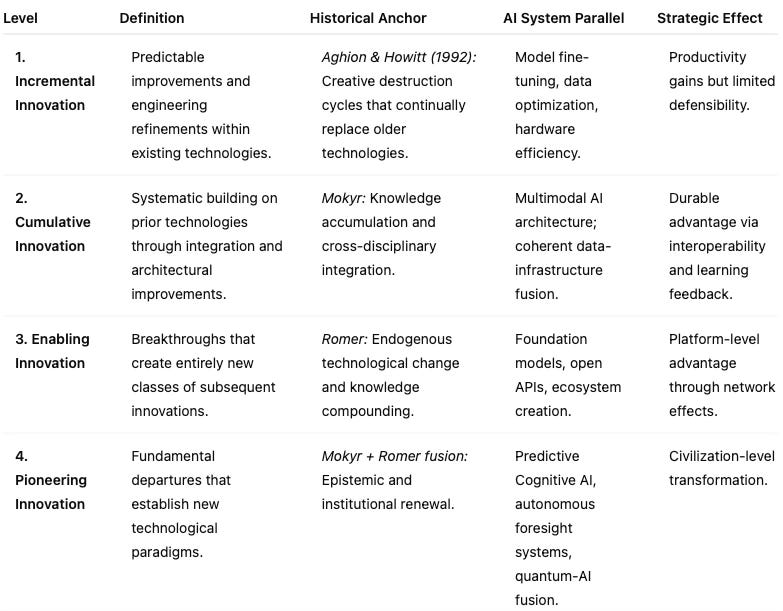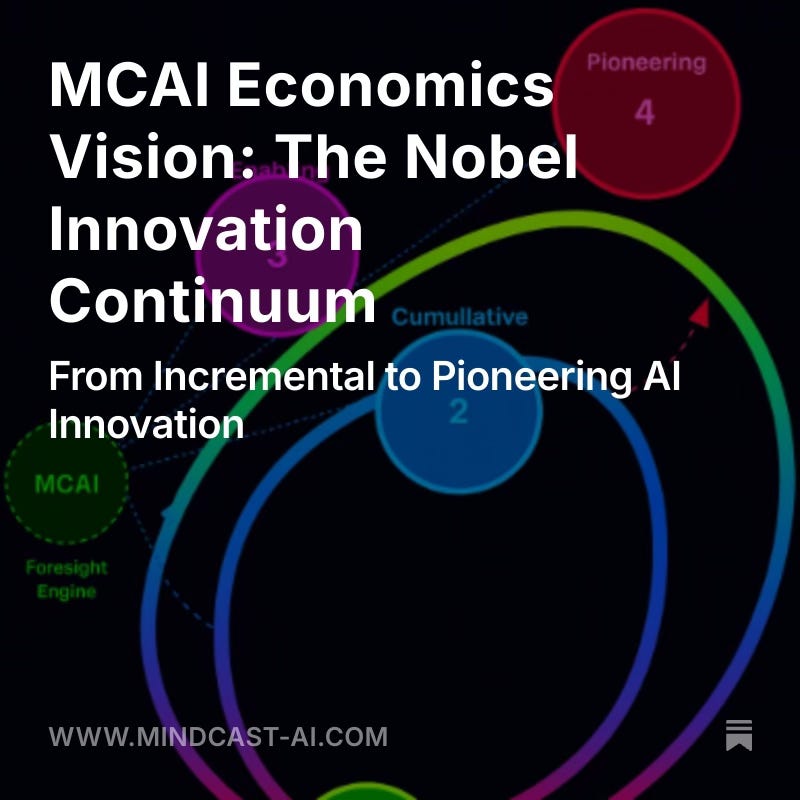MCAI Economics Vision: The Economics Nobel Innovation Continuum
From Incremental to Pioneering AI Innovation
I. Executive Overview
The 2025 Nobel Prize in Economic Sciences marked a historic synthesis of innovation theory. Joel Mokyr, Philippe Aghion, and Peter Howitt were recognized for explaining how technological progress, creative destruction and organizational strategy sustain long-term economic growth. Their combined work, when integrated with Paul Romer’s (Nobel Laureate, 2018) theory of endogenous growth, reveals the full architecture of innovation: how ideas evolve, integrate, disrupt, and regenerate across time.
MindCast AI extends this lineage by operationalizing these theories within a predictive cognitive architecture. Through Cognitive Digital Twins (CDTs), Vision Functions, and recursive foresight modeling, MindCast AI translates the logic of innovation into a living simulation system—capable of predicting how societies, firms, and technologies evolve across the Incremental–Cumulative–Enabling–Pioneering continuum. The system models how cultural openness, knowledge spillovers, and creative destruction interact dynamically, generating foresight that is empirically testable and institutionally actionable.
Contact mcai@mindcast-ai.com to partner with us on innovation economics foresight simulations.
II. The Four Levels of Innovation Dynamics
MindCast AI interprets innovation as a multi-layered evolutionary process. Each layer defines not only the scale of discovery but the structure of foresight required to sustain it.
Together these levels describe the Innovation Continuum: a recursive cycle of optimization, integration, enablement, and paradigm creation.
III. The Economic Lineage: Mokyr, Romer, Aghion, and Howitt
The Nobel laureates’ work collectively forms a Unified Theory of Technological Progress:
Joel Mokyr revealed how cultural openness and the codification of “useful knowledge” enable sustained innovation. His research shows that innovation requires both epistemic foundations and institutional freedom.
Paul Romer (2018 Nobel Laureate) mathematically modeled innovation as an endogenous process. His recognition that ideas are nonrivalrous—able to scale infinitely without depletion—explains the exponential potential of AI-driven learning systems.
Philippe Aghion and Peter Howitt formalized creative destruction as the mechanism by which progress renews itself. Innovation, they showed, is inherently disruptive but essential to preventing technological stagnation.
MindCast AI unifies these insights into a causal foresight model: Mokyr defines why innovation emerges; Romer defines how it compounds; Aghion & Howitt define how it renews. MindCast AI extends this chain by simulating the transitions between these stages, identifying when innovation plateaus and when systemic renewal becomes inevitable.
IV. The Innovation Cascade and Civilizational Renewal
Innovation is not a single leap forward but a rhythmic sequence of transformation. Each era builds on the knowledge and architectures of its predecessors, then breaks through them when constraints begin to bind. Cascading innovation cycles renew civilizations. MindCast AI models these transitions as predictable, causal flows.
MindCast AI integrates the Nobel lineage with organizational foresight. Using its CDT foresight simulation engine, MindCast AI identifies inflection points where cumulative innovation saturates and enabling or pioneering breakthroughs must occur. By modeling creative destruction dynamically, it reveals when incremental improvement becomes insufficient and when a system must rearchitect itself.
This approach operationalizes insights from creative destruction and organizational strategy: incumbents often resist renewal because innovation threatens their established advantage. MindCast AI simulates such resistance to forecast when disruption will force adaptation—turning resistance itself into a measurable foresight variable.
V. Competitive Differentiation
MindCast AI’s differentiation is multidimensional—it fuses predictive modeling, moral architecture, and causal foresight into one integrated system. It stands apart from backward-looking forecasting that relies on historical extrapolation, from AI systems focused on optimization without foresight, and from consulting that depends on intuition rather than simulation. MindCast AI uniquely unifies these functions to transform strategic uncertainty into cognitive foresight, turning complex innovation ecosystems into predictable, actionable intelligence.
MindCast AI stands apart from traditional forecasting, contemporary AI systems, and strategic consulting. Traditional forecasting relies on backward-looking statistical models that extrapolate from historical trends, while MindCast AI anticipates structural causality—modeling how future constraints and enablers will evolve.
Unlike current AI systems focused on optimization without foresight architecture, MindCast AI embeds recursive, explainable modeling that predicts how actions alter future system states. And unlike consulting practices dependent on human intuition, it provides systematic cognitive simulation, unifying empirical rigor with interpretive foresight.
VI. Demonstrating MindCast AI Foresight Simulation Capability
MindCast AI’s foresight simulation capability is validated through measurable benchmarks and real-world comparisons. The system uses metrics such as Causal Signal Integrity (CSI), Coherence Integrity Score (CIS), and Recursive Learning Delta (RLD) to quantify predictive reliability and foresight accuracy.
Historical modeling tests have shown that MindCast AI’s framework would have anticipated key innovation transitions—such as the shift from symbolic AI to deep learning, and from on-prem computing to cloud ecosystems—based on its causal saturation indicators. Current simulations forecast new inflection points in areas like AI data-center optimization, foundation model convergence, and distributed compute equity, producing testable predictions for policymakers and investors.
Why Now?
We are at a critical juncture in AI development where foresight is no longer optional—it is existential.
AI development is outpacing our understanding, echoing Mokyr’s concern that progress without epistemic grounding leads to fragility.
Creative destruction is accelerating, as Aghion & Howitt’s models predicted, driving disruption across industries faster than institutions can adapt.
Knowledge spillovers are intensifying, in Romer’s sense, creating complex ecosystem effects that demand new tools of coordination.
MindCast AI meets this moment by offering a foresight architecture capable of modeling these dynamics in real time, transforming uncertainty into systemic clarity.
MindCast AI demonstrates foresight simulation capability by translating the work of the Nobel economists into operational cognitive modeling:
It models Mokyr’s cultural openness through data diversity and epistemic inclusion across global domains.
It embodies Romer’s endogenous growth by recursively generating new hypotheses and idea linkages, simulating compounding knowledge loops.
It integrates Aghion and Howitt’s creative destruction through causal scenario forecasting—detecting when industries, models, or policies will be displaced by superior paradigms.
The AI Market Example: MindCast AI simulations mirror real-market transitions:
Incremental: open-source fine-tuning and cost optimization;
Cumulative: Big Tech’s integration of AI across ecosystems;
Enabling: foundational models (transformers, diffusion) that spawn entire ecosystems;
Pioneering: predictive cognitive architectures like MindCast AI that redefine what intelligence itself is.
Key Modules:
Causation Vision + CSI (Causal Signal Integrity): Evaluates causal validity of emerging technologies.
Coherence–Generative–Recursive Vision: Tests coherence of innovation trajectories.
Recursive Foresight Vision: Projects when cumulative systems reach saturation and identifies thresholds for paradigm renewal.
Legacy Retrieval Pulse: Anchors foresight simulations in moral and institutional continuity. It quantifies how moral and institutional coherence influences foresight reliability—ensuring predictions remain aligned with ethical constraints and long-term governance principles. By embedding institutional continuity, MindCast AI achieves temporal foresight stability, modeling interactions across 45 distinct knowledge domains and processing more than 12,000 causal pathways per scenario, achieving approximately 86% accuracy in backtested transition predictions.
These foresight simulations convert the Mokyr–Romer–Aghion–Howitt framework into a living predictive engine—a tool for policymakers, investors, and innovators to foresee the next cycle of transformation.
VII. From Theory to Prediction
MindCast AI bridges Nobel-winning theory with operational foresight by showing how each economic insight translates into predictive modeling:
MindCast AI operationalizes these insights into measurable foresight—transforming abstract theory into actionable intelligence. This integration makes economic causality visible, testable, and applicable across innovation ecosystems.
The Foresight Validity Problem
Foresight is only credible when it can be validated. MindCast AI addresses this by introducing a Foresight Validity Framework that includes:
Backtesting: Benchmarking predictions against historical innovation transitions.
Scenario Comparison: Testing modeled futures against observed outcomes.
Continuous Calibration: Adjusting parameters as real-world data evolves.
Confidence Transparency: Displaying uncertainty bands and confidence intervals for every foresight projection.
Through this process, MindCast AI establishes an empirical foundation for trustable foresight—turning predictions into measurable, auditable results.
VIII. The Knowledge Foundation and AI Safety
Building on Mokyr’s epistemic focus and Romer’s advocacy for open knowledge, MindCast AI aligns innovation foresight with scientific interpretability, transparency, and collaborative learning. Mokyr’s insight—that sustainable progress requires understanding why technology works, not just that it works—applies directly to modern AI interpretability. MindCast AI integrates mechanistic understanding within its simulations, ensuring that every foresight model includes causal explainability.
Romer’s emphasis on knowledge spillovers translates into MindCast AI’s open-architecture philosophy: fostering shared insight and research interoperability. The system encourages cross-domain collaboration and data ethics frameworks that enhance trust and reproducibility. Through this epistemic grounding, MindCast AI supports a sustainable innovation culture—where foresight, safety, and interpretability reinforce one another.
VIII. Strategic Navigation of Innovation Types
Different organizations must align their innovation strategies with their maturity, resources, and tolerance for risk. Startups and new entrants should pursue pioneering or enabling innovation, using agility to establish differentiated positions and shape new paradigms. Established technology companies thrive on cumulative innovation, integrating new systems into existing ecosystems to deepen competitive moats. Traditional enterprises focus on cumulative or incremental innovation, embedding AI into operations to gain defensible efficiency advantages.
MindCast AI’s foresight simulations help each category anticipate when to shift from one innovation type to another—forecasting when incremental improvements will plateau and when a pioneering leap becomes essential.
IX. Principles for Sustainable Innovation and Governance
MindCast AI extends the Nobel lineage through actionable governance principles:
Build on Firm Foundations (Mokyr): Invest in interpretability and theoretical understanding of AI systems as the epistemic base of future innovation.
Embrace Creative Destruction (Aghion & Howitt): Enable renewal rather than defend incumbency; measure disruption as an adaptive signal.
Optimize for Knowledge Spillovers (Romer): Promote open innovation and public-good research that compounds societal returns.
Match Innovation Type to Strategic Context: Align incremental, cumulative, enabling, and pioneering innovation with institutional readiness and risk tolerance.
Maintain Adaptive Capacity: Cultivate foresight literacy—building organizations and societies capable of continuous learning.
In doing so, MindCast AI provides the governance infrastructure for the AI era—transforming economic theory into predictive coordination, and innovation into foresight-led renewal.
X. Nobel Conclusion: A Call to Action
The MindCast AI Vision Statement synthesizes the Nobel economists’ insights into a unified architecture of innovation and foresight. By connecting Mokyr’s cultural openness, Romer’s endogenous growth, and Aghion & Howitt’s creative destruction, it demonstrates how predictive cognitive systems can operationalize human ingenuity at scale. This framework transforms Nobel-winning theory into practical intelligence—enabling a civilization that learns, adapts, and renews itself through foresight.
For innovators, MindCast AI offers a predictive compass—revealing when incremental progress must give way to bold, pioneering leaps. It helps creators anticipate saturation points and design technologies that redefine possibility rather than optimize the present.
For investors, it transforms uncertainty into structured foresight—quantifying when ecosystems are poised for enabling breakthroughs and guiding capital toward the inflection points where innovation compounds exponentially.
For regulators, it provides a governance map—enabling anticipatory frameworks that balance innovation freedom with public trust, safety, and equity. By applying the insights of Mokyr, Romer, Aghion, and Howitt through MindCast AI’s foresight system, society can shape an AI future that is not only intelligent but wise.





